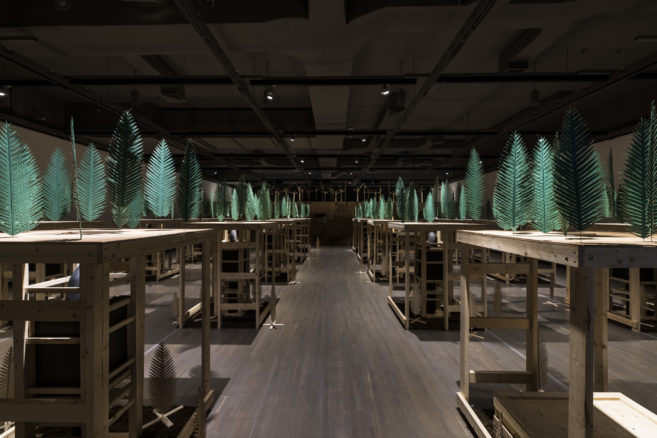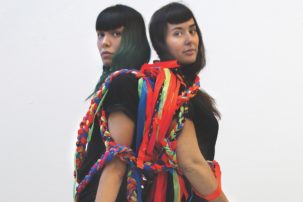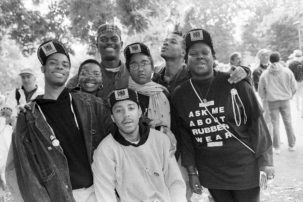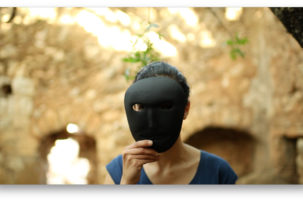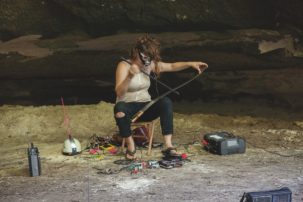Whenever someone asks what I’ve been consuming lately, I answer, “pure trash.” Though always a lover of trash content, I’ve observed an uptick in my consumption since the reality of COVID-19 set in and isolating at home became, for many, essential. Reality television and action-movie franchises, binged over several days, and takeout containers and the plastic bags they came in have become my own private trash mountain. I use the term “trash” with affection to describe good-looking people trying to find love in pods, white women selling ridiculously overpriced real estate and street racers cruising through downtown Tokyo. Consuming trash has kept my brain occupied and acted as a balm for uncertainty; where the story arcs are ridiculous but simple to follow, the outcome clear and predictable. In pure trash content, there is drama but no one dies—and if they do, they often come back later in the franchise.
To protect ourselves from the virus, we’re told, we must enter into continuous acts of creating garbage, while we send that garbage to other countries, and as we wash our hands over and over again.
This, of course, is my privilege and my responsibility; to stay indoors in my home, wasting time in the fantasy offered by free entertainment. Trash has infiltrated my daily life in more tactile ways: with the protocol of no contact, there is also the limited possibility of reuse. From disposable masks to sanitizing wipes, plastic gloves and takeout containers, single-use items have become the norm again, creating a boom for the plastics industry. During the pandemic, the goal has become one-use-only living for the sake of public health. To protect ourselves from the virus, we’re told, we must enter into continuous acts of creating garbage, while we send that garbage to other countries, and as we wash our hands over and over again.
How then does art respond to trash—both the heaps of the past and those being formed, more so than usual, in the present? Between TV binge sessions and moments of mild panic, I’ve been contemplating the work of two Canadian artists who engage with trash and waste in their artistic practices, sorting through the power dynamics inherent in how we decide what to throw away.
My relationship with trash has always been personal. Growing up, I was schooled in the hierarchy of what some might consider garbage, raised in a household that viewed every item as reusable, full of alternative potential. Under the sink, my mother kept the “barely used” napkins: a bit worn but still good enough to wipe up a spill until they eventually disintegrated with use, back to pulp. She carefully washed plastic bags and dried them inside out so they could be used again, a “waste-not” system born out of necessity and practicality, and inherited from her parents. Our kitchen was always covered in drying plastic bags, like stippled ghosts, and plastic tubs filled with napkins that bore the stains of our family meals. Only later, outside of my family’s value system, would I realize the way “trash” was given such important value.
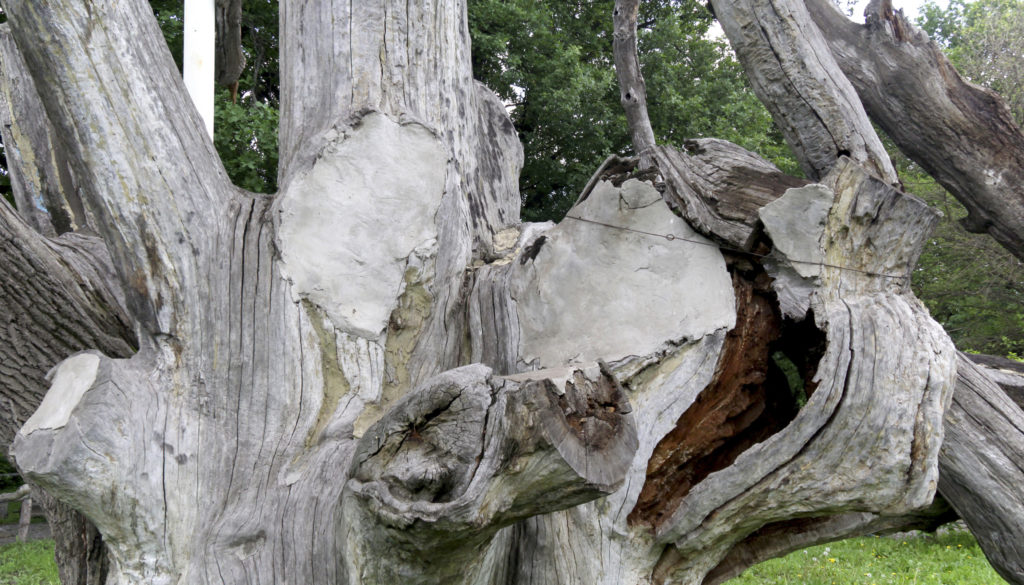 Kandis Friesen, Towards rock, towards ground, we are drowning, we our building, 2020. Pigment prints on archival cotton rag mounted on Dibond. Courtesy TRUCK Contemporary Art.
Kandis Friesen, Towards rock, towards ground, we are drowning, we our building, 2020. Pigment prints on archival cotton rag mounted on Dibond. Courtesy TRUCK Contemporary Art.
In Kandis Friesen’s recent exhibition “Tape 158: New Documents from the Archives” at Calgary’s TRUCK Contemporary Art, the artist’s medium is the trash left behind by historical events: fallen monuments; an ancient, decomposing tree; forgotten unedited footage of a Mennonite community in Ukraine. Due to the pandemic, the gallery closed to visitors before the show officially opened. I was able to view the work only through documentation provided by Friesen, an archive of the archive.
Friesen has a similarly intimate connection to trash, recalling childhood memories of her Ukrainian grandmother’s dried and folded plastic bags. “In many ways, I grew up in a series of archives,” she told me recently in an interview for Public Parking, “some of them were quite cohesive and recognizable, as spaces of historic documents and information, and some of them were chaotic, intuitive, and much more opaque; requiring a different kind of reading and attention.”
Friesen often recreates found footage by travelling to the physical space where it was originally filmed—what she calls repeating an echo—and interviewing subjects decades after their initial conversations about their experiences with war, conflict and displacement. During our conversation, she spoke about her work in relation to Svetlana Boym’s concept of “diasporic intimacy,” in which exiled people make their lives into art to cohabitate with their memories of home. This art often takes the place of formal documentation that was destroyed or never existed. Friesen’s work considers what is lost and gained through the preservation of these histories, expanding on a more complicated idea of identity and displacement raised by Boym. “In contrast to the utopian images of intimacy as transparency, authenticity, and ultimate belonging, diasporic intimacy is dystopian by definition; it is rooted in the suspicion of a single home,” notes Boym in her text.
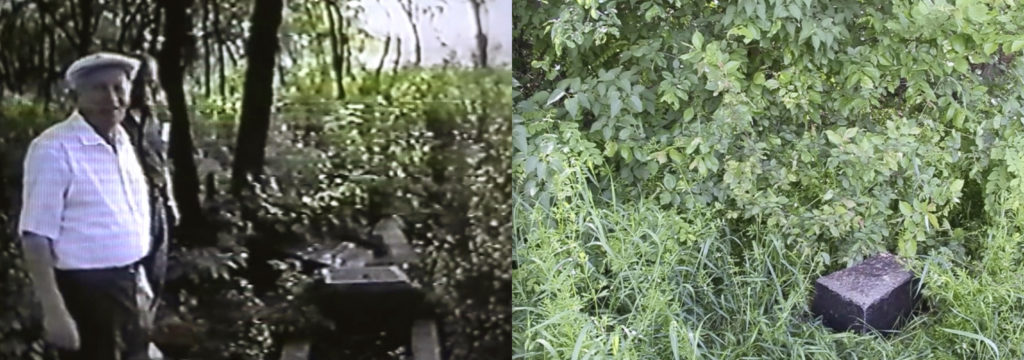 Kandis Friesen, Green Fields (still), 2016–2019. Two-channel stereo sound and SD video installation, 18 min loop. Courtesy TRUCK Contemporary Art.
Kandis Friesen, Green Fields (still), 2016–2019. Two-channel stereo sound and SD video installation, 18 min loop. Courtesy TRUCK Contemporary Art.
In Friesen’s show, the base of a destroyed Lenin statue and old interview footage become intimate trash in a new context. Friesen works with partly destroyed or completely hidden materials to build an ongoing archive of histories that were considered disposable, not worth keeping or remembering. Each piece feels thick and heavy with references, a collage of scraps that have been salvaged and reanimated. I recognize my own sense of diaspora in the silent video collage of remade images in the mixed-media installation Green Fields (2016–19), in which elders from the community of Zelene Pole in Ukraine recall a war of the past that could very well reflect the conflicts of the present. Another video piece, Oak of Khortitsa (After Courbet) (2018), documents an oak tree in Ukraine believed to be almost 1000 years old, held up with metal supports, a barely-living monument that is venerated and honoured by the community, despite being in the process of decomposition.
Friesen’s show touches on how the objects we create and destroy continue to haunt us; trashing monuments does not erase their historical imprints. Her ongoing archive reflects the current conversation around the value of historical monuments, which have remained standing for so long because governments deem them worth preserving. These icons of stone and metal are being toppled with the sanction of governments or by force by protestors on a global scale, and yet the histories they represent will live on in the bodies of people. Their presence will never be fully eradicated, similar to the ghostly archive Friesen creates in her work, and they will never completely break down or return to the earth.
Friesen’s show touches on how the objects we create and destroy continue to haunt us; trashing monuments does not erase their historical imprints.
Where Friesen’s show examines the ephemeral, hidden forms of trash, Tsēmā Igharas’s exhibition “Black Gold,” at Untitled Art Society in April 2019, looked at the origins of our waste and traced our continued consumption of raw materials from the earth. Trash is often considered to be the products themselves, processed and packaged into something recognizable: a Styrofoam cup, an old pair of flip-flops, ripped tires in a scrap heap. Standing in Igharas’s show, with the gallery walls painted pitch black to reflect the texture and colour of bitumen, I realized I was surrounded by the raw material that fuels much of my garbage. The space became a portal, where raw bitumen, which is processed into crude oil and fuel, became linked to the consumption and transport of recognizable, everyday items.
In “Black Gold,” Igharas connected the mining of bitumen to the Indigenous use of obsidian, a traditional practice of sustainable extraction that occurred on sacred Indigenous lands. Communities such as the Tahltan First Nation mined obsidian in small quantities for thousands of years to trade and use to make weapons. Under the current practices of the petroleum industry, the waste-heavy process of creating bitumen has usurped the sustainable use of obsidian by Indigenous communities. As a result of bitumen extraction, many of these communities are now living on land that leeches toxic waste, which creates lasting, damaging effects on the ecosystem.
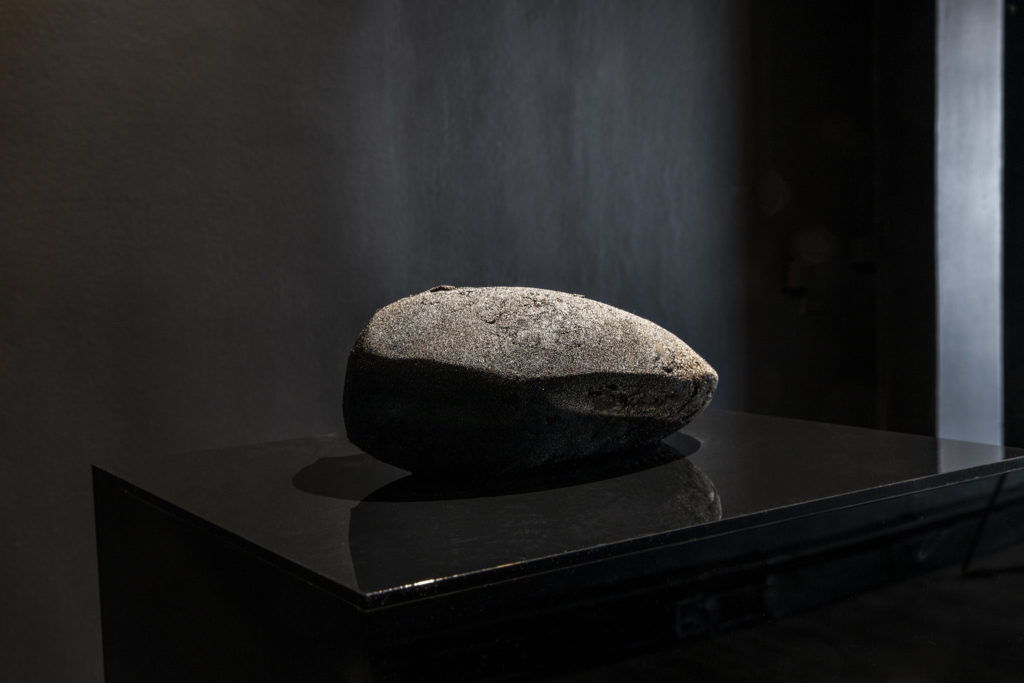 Tsēmā Igharas, “Black Gold,” Untitled Art Society, 2019. Courtesy the artist and Untitled Art Society. Photo: Katy Whitt.
Tsēmā Igharas, “Black Gold,” Untitled Art Society, 2019. Courtesy the artist and Untitled Art Society. Photo: Katy Whitt.
An artist from Tahltan Territory, Igharas conducted a series of research trips to the Athabasca oil sands for her project, speaking with industry workers and Indigenous leaders linked together through a complex system of consumption. When resources are extracted from Canada’s oil sands and turned into various petroleum products, it becomes easier to disregard their original state, as well as the toxic processes required to create them. Igharas acknowledges the damaging affects of resource extraction, as well as our shared dependency on an industry that creates access to everyday products and employment for many Indigenous communities.
One of the show’s most powerful pieces was raw bitumen itself, black and noxious, sculpted into the shape of a stomach. The material looked tactile and alien, divorced from its processed form. Other pieces in the show were beautiful in form but imbued with darker meaning: a curved copper sculpture that reflected light and colour, and a Tahltan tent made of copper poles and overlaid with a blanket adorned with abalone buttons. The copper sculpture, made of melted copper pennies, referenced the mineral value of copper in Tahltan Territory. The blanket’s abalone buttons, traditionally used on regalia, traced the pattern of smoke from forest fires in Tahltan Territory that burned during Igharas’s research process. This smoke wafted over the Rockies and reached Igharas on the oil sands in Alberta, connecting the two locations.
By recontextualizing raw materials like copper and bitumen, Igharas asked us to consider these resources at their origin, and in their original form, moving them away from abstraction and toward the physicality of the land. She also drew on other materials from her home territory, such as jars of wild salmon, which she placed in a core-sample box commonly used in the oil industry. This piece might be confusing to most art folks but instantly recognizable to those familiar with the oil industry; a nod to the possible gaps of awareness in her audience.
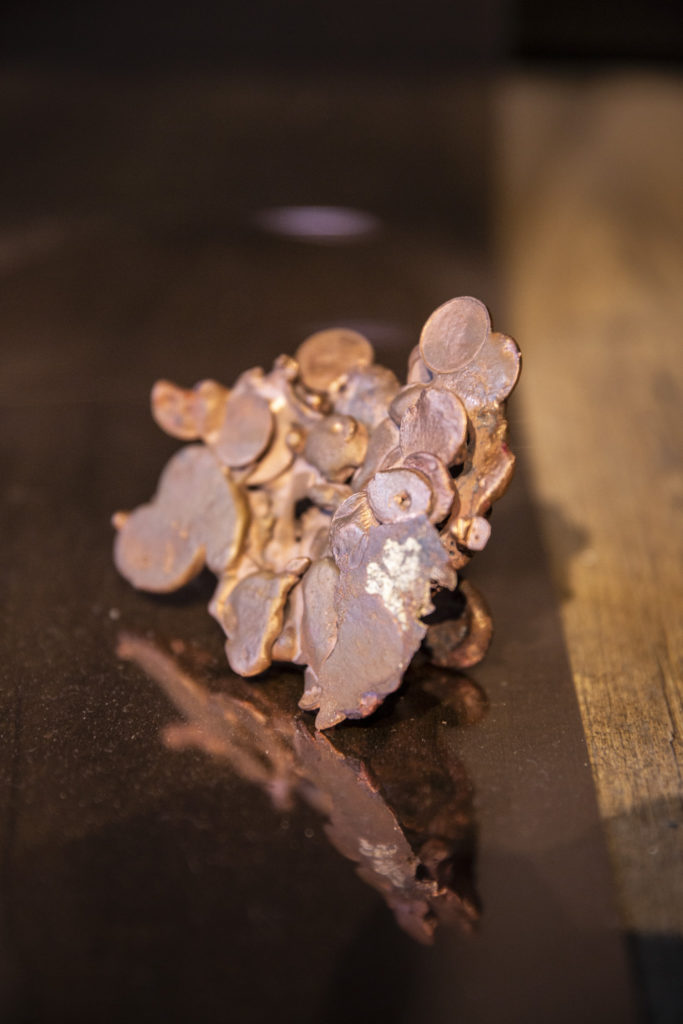 Tsēmā Igharas, “Black Gold,” Untitled Art Society, 2019. Courtesy the artist and Untitled Art Society. Photo: Katy Whitt.
Tsēmā Igharas, “Black Gold,” Untitled Art Society, 2019. Courtesy the artist and Untitled Art Society. Photo: Katy Whitt.
For both artists, “pure trash” is pure fantasy; there is nothing simple or pure about the physical and historical weight of consumption.
Like Friesen’s work, “Black Gold” was about true engagement with the lineage of our garbage, bearing witness to how we consume resources to create energy or reshape raw materials to make a Styrofoam cup that won’t decompose for hundreds of years. By framing the aesthetics of raw materials with their histories and consequences, Igharas has implicated all of us in this process and revealed our ongoing participation in a system predicated on the necessity of waste.
In our conversation, Friesen argued against the notion that an archive is about the past. “They are very contemporary in the sense that they are present,” she noted. “The tension for me is in their legibility as ‘present,’ and therefore their relationship to possible pasts or possible futures.” If trash can act as an archive, as evidence of colonial violence, as an inevitable byproduct of capitalist systems, or even as a form of easy entertainment, it can also tell us a lot about our capacity to consume, which feels endless, particularly now. By honouring trash as a source of knowledge and value, and by linking it back to its origins, both Friesen and Igharas ask us to examine how and why the things we throw away keep returning to us in different forms.
For both artists, “pure trash” is pure fantasy; there is nothing simple or pure about the physical and historical weight of consumption. As the pandemic spills into winter, I try to reduce the amount of stuff I consume, from takeout containers to disposable masks to delivery boxes. I recognize the things that I can preserve, like washing plastic bags as my mother taught me, while another episode of garbage TV cues up in the background. This is the joy and disgust, after all, found in trash.

 Tsēmā Igharas, “Black Gold,” Untitled Art Society, 2019. Courtesy the artist and Untitled Art Society. Photo: Katy Whitt.
Tsēmā Igharas, “Black Gold,” Untitled Art Society, 2019. Courtesy the artist and Untitled Art Society. Photo: Katy Whitt.
